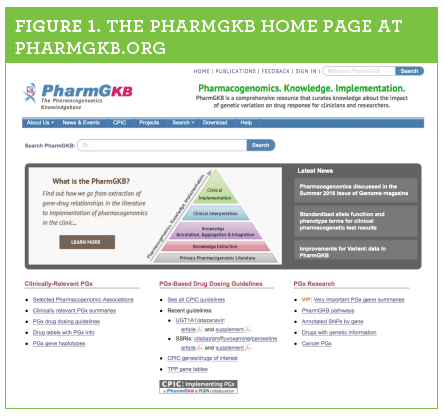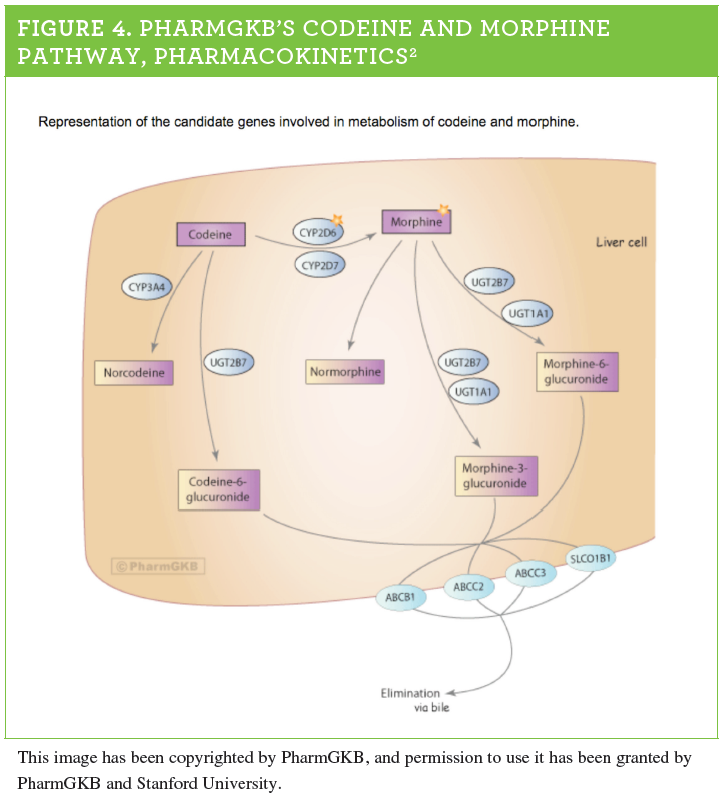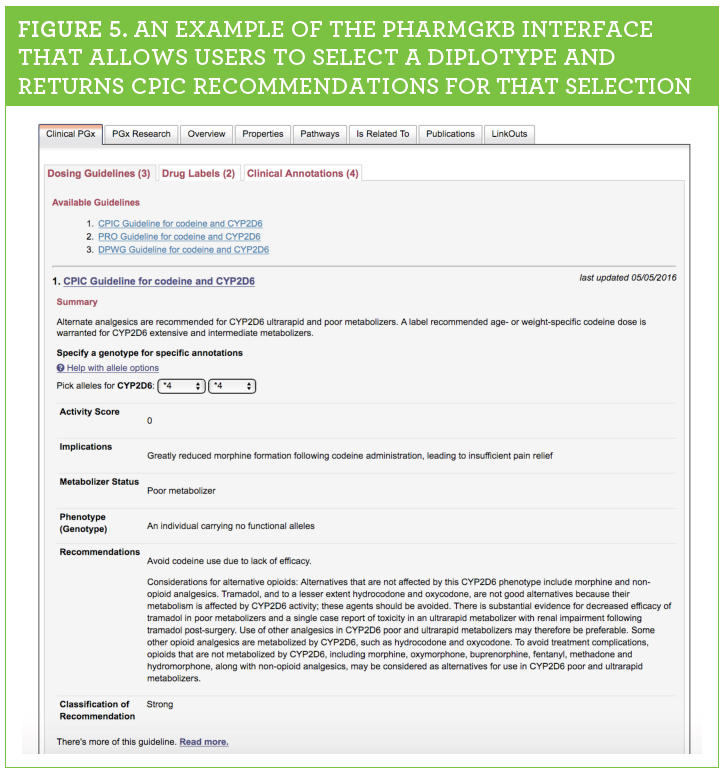Pharmacogenetic Resources: PharmGKB and Clinical Pharmacogenetics Implementation Consortium
Pharmacogenetics is the study of how genes impact drug response, an integral part of personalized medicine.
Pharmacogenetics is the study of how genes impact drug response, an integral part of personalized medicine. The basis of pharmacogenetics is an understanding of how specific genetic variation results in differing drug efficacy and/or adverse events. More important to patients is the translation of that understanding into drug prescribing and dosing suggestions based on patient genotypes and implementation of a rule-based approach to integrating patient genotypes in the prescribing process. Resources exist to support the translation of pharmacogenetic concepts into the clinic by clinicians, including pharmacists, physicians, and genetic counselors. In this article, 2 such resources are introduced.

The Pharmacogenomics Knowledgebase1 (PharmGKB) is the premier repository of pharmacogenetic information. Its mission is to identify, annotate, aggregate, and disseminate pharmacogenetics knowledge. PharmGKB’s website (pharmgkb.org; Figure 1) encompasses a multitude of resources, including genotype-based drug dosing/prescribing guidelines, drug labels with biomarker information, pharmacokinetics and pharmacodynamics drug-centric pathways, and summaries of important pharmacogenetic associations.
The resource began as an National Institutes of Health (NIH)—funded project, in 2000, to store genotype and phenotype data deposited from research sites across the United States. The original users of PharmGKB were researchers looking to discover new connections between drugs and genes. However, it quickly became apparent that potential PharmGKB users were interested in more than these basic research associations. People visiting the PharmGKB website were interested in what genes and, more specifically, what variants had been demonstrated to have an impact on drug response. They wanted to know what the phenotypic result was for a given allele based on peer-reviewed evidence. PharmGKB responded to this demand by transitioning from a basic research database to a knowledge resource and became the primary source for pharmacogenetic information, from preliminary research to associations with the potential to inform patient care. Current PharmGKB users include students, pharmacists, genetic counselors, clinicians, researchers, and the public.
Scientists at PharmGKB scour major pharmacogenetics and pharmacogenomics journals to identify relevant studies and hand curate information. These scientists have PhDs and master’s degrees, along with extensive training in fields such as cellular and molecular biology, pharmacology, and human genetics. They carefully read peer-reviewed articles and capture study details, including patient population, study size, allelic variants, and association statistics (Figure 2). For each article, 1 or more variant-based summary sentences are written to report the major findings. Standardized vocabularies, such as HUGO Gene Nomenclature Committee gene symbols, DrugBank drug names, and National Library of Medicine Medical Subject Headings (MeSH) disease terms, are used in the article annotations and throughout PharmGKB.
Figure 2: Annotation of CYP2D6 Haplotype

As the field of pharmacogenomics progresses, some findings are replicated, sometimes in different or larger populations, sometimes with stronger statistical or in vitro evidence. Conversely, some preliminary findings may not be successfully replicated by follow-up studies. Growing evidence can lead to changing views on the significance or strength of an association. It is important to have an overall understanding of reported associations in addition to understanding individual study findings. PharmGKB scientists write genotype- or haplotype-based summaries of pharmacogenetic associations across all annotated studies in PharmGKB; these are called clinical annotations (Figure 3). These summaries are useful in understanding the totality of evidence for a particular pharmacogenetic association between a given patient genotype and drug response.

The information collected through literature reviews is also used at PharmGKB to construct pharmacokinetics and pharmacodynamics drug-centered pathways (Figure 42) and “very important pharmacogene” (VIP) reviews. Researchers can use these materials to generate hypotheses and candidate gene lists for future research. Teachers, authors, and lecturers use the pathway figures to illustrate pharmacogenetic concepts. Clinicians and others can use the pathways and reviews to succinctly describe the mechanisms and importance of pharmacogenetic associations to give context to genotype-based drug prescribing guidelines.

PharmGKB provides access to published pharmacogenetic guidelines from multiple groups worldwide, including the Dutch Pharmacogenetic Working Group3 and the Clinical Pharmacogenetics Implementation Consortium4 (CPIC; see below). Specifically, for CPIC guidelines, PharmGKB provides an interface that allows selection of a given genotype or diplotype and returns the CPIC recommendations for the guideline drug(s) (Figure 5).

Additionally, guideline pages present a summary table of recommendations (eg, genotypes/diplotypes and phenotypes). All guideline manuscripts, supplements, and additional supporting documents are available for download from the website.
THE CLINICAL PHARMACOGENETICS IMPLEMENTATION CONSORTIUM
CPIC4 (cpicpgx.org) was created as a partnership between PharmGKB and the Pharmacogenomics Research Network (PGRN), in 2009, to address barriers to pharmacogenetics implementation. In surveys of CPIC members and American Society for Clinical Pharmacology and Therapeutics (ASCPT) members conducted by CPIC,4 responses indicated that barriers to implementation included uncertainty about which drug/gene pairs were actionable and how to translate genotypes to clinical actions. Responses also included concerns about test costs and reimbursements, as well as general clinician resistance to considering pharmacogenetic information. CPIC’s goal is to address the first 2 barriers with the creation of freely available, peer-reviewed, genotype-based drug prescribing guidelines written by expert pharmacogeneticists and clinicians.
Guidelines are written with the knowledge that patient genotypes are already available and do not provide recommendations as to whether to perform genetic tests. The idea is that, with the growing availability of genomic testing and simultaneously decreasing testing costs, preemptive genotyping or sequencing will become more common and clinicians will be faced with how to act on that information in the patient record.
Each guideline focuses on a drug or drug class and 1 or more genes with a variation known to impact phenotype. Gene and drug background summaries are provided in addition to evidence from a focused literature review supporting the provided prescribing or dosing recommendations. Literature evidence is assigned a quality rating based on specific criteria, and all recommendations are given a strength score (strong, moderate, or optional).4 CPIC guidelines have a standardized format and are written according to a standard operating process that has been published.5 Tables 1 and 2 in guideline manuscripts summarize the prescribing or dosing recommendations. It is important to note that due to journal restrictions on manuscript size, important supporting information (eg, extensive allele variant and function definitions, genetic testing interpretation information, and supporting resources) are included in the guideline supplement. All supplements and other supporting documents are available at pharmgkb.org and cpicpgx.org.
CPIC guidelines are cited by NIH’s Genetic Test Registry, and several have been endorsed by the American Society of Health- System Pharmacists and the ASCPT. Guidelines are also deposited in the National Guideline Clearinghouse (guideline.gov).
Together, PharmGKB and CPIC provide excellent resources for clinicians interested in pharmacogenetic translation and implementation in patient care.
ACKNOWLEDGEMENTS
PharmGKB (R24 GM61374) and CPIC (R24 GM115264) are supported by the NIH. Michelle Whirl-Carrillo, PhD, and Teri E. Klein, PhD, are paid scientific advisors to MD Labs and the Rxight Pharmacogenetic Testing Program.
Michelle Whirl-Carrillo, PhD, and Teri E. Klein, PhD, work in the Department of Genetics, Stanford University, Stanford, California. In addition, Michelle Whirl-Carrillo is the associate director of PharmGKB, and Teri E. Klein is the co-principal investigator and director of PharmGKB and the co-principal investigator of the Clinical Pharmacogenetics Implementation Consortium.
References
- Whirl-Carrillo M, McDonagh EM, Hebert JM, et al. Pharmacogenomics knowledge for personalized medicine. Clin Pharmacol Ther. 2012;92(4):414-417. doi: 10.1038/clpt.2012.96.
- Thorn CF, Klein TE, Altman RB. Codeine and morphine pathway. Pharmacogenet Genomics. 2009;19(7):556-558. doi: 10.1097/FPC.0b013e32832e0eac.
- Swen JJ, Nijenhuis M, de Boer A, et al. Pharmacogenetics: from bench to byte—an update of guidelines. Clin Pharmacol Ther. 2011;89(5):662-673. doi: 10.1038/clpt.2011.34.
- Relling MV, Klein TE. CPIC: Clinical Pharmacogenetics Implementation Consortium of the Pharmacogenomics Research Network. Clin Pharmacol Ther. 2011;89(3):464-467. doi: 10.1038/clpt.2010.279.
- Caudle KE, Klein TE, Hoffman JM, et al. Incorporation of pharmacogenomics into routine clinical practice: the Clinical Pharmacogenetics Implementation Consortium (CPIC) Guideline Development Process. Curr Drug Metab. 2014;15(2):209-217.

